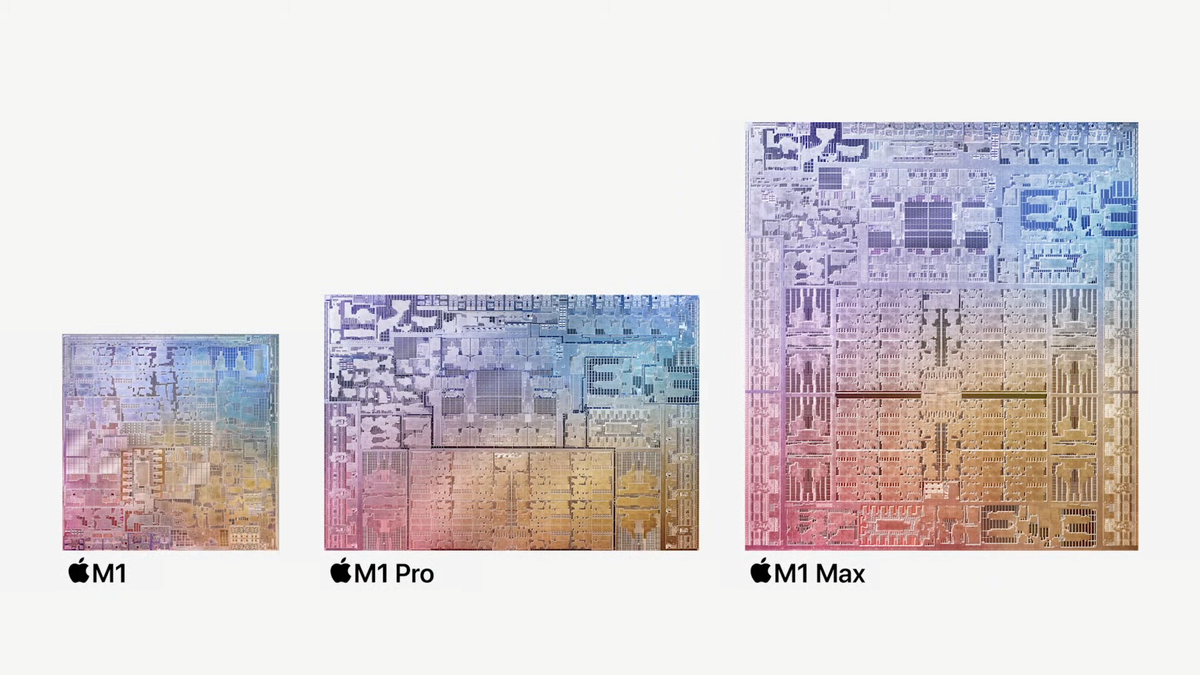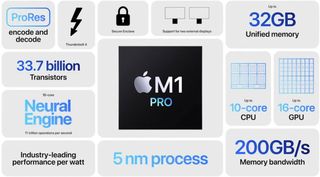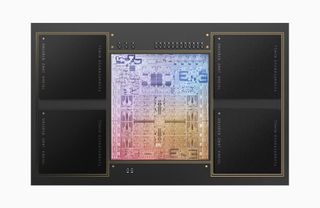Apple continues its crusade to ban Intel from its line with two more processors: the M1 Pro and the M1 Max, professional-grade processors making their debut in the market. 14-inch and 16-inch MacBook Pro.
Here’s everything you need to know about the M1 Pro and M1 Max in one place. We also have a separate article on the Original M1.
Apple M1 Pro and M1 Max specifications
| M1 | M1 Pro | M1 Max | |
|---|---|---|---|
| Process node | 5 nm | 5 nm | 5 nm |
| Transistors | 16 billion | 33.7 billion | 57 billion |
| Processor cores | 8 | 8 or 10 | ten |
| GPU cores | 7 or 8 | 14 or 16 | 24 or 32 |
| Memory bandwidth | 68.25 GB / s | 200 GB / s | 400 GB / s |
| Maximum memory | 16 GB | 32 GB | 64 GB |
To boost the M1 Pro and M1 Max over the original M1, Apple has done a lot of work on memory bandwidth and increased the number of cores. While M1 has an 8-core processor and up to a 7-core GPU, the M1 Pro goes up to 10 processor cores and up to 16 GPU cores (although the base 14-inch MacBook Pro have slightly watered-down versions of both). The M1 Max has 10 CPU cores and 24 or 32 GPU cores depending on what configuration you get.
Has 57 billion transistors. the M1 Max is the largest processor Apple has ever made while the M1 Pro has 33.7 billion transistors. Both are made on the same 5 nanometer process as the existing M1.
Another huge difference is the memory bandwidth. Where M1 hits 68.25 GB / s, the M1 Pro climbs to 200 GB / s and the M1 Max hits 400 GB / s.
The M1 Pro and M1 Max both have the same 16-core neral engine for machine learning tasks. In addition, both MacBook Pros are equipped with fans for cooling. The M1 went fanless in the MacBook Air, while the 13-inch MacBook Pro and Mac Mini both used fans.
Apple M1 Pro and M1 Max performance
With the first official reviews on the web, we got a better idea of ​​how the M1 Pro and M1 Max performed.
Silicon side, Anandtech went deep. Regarding the processor, Anandtech convenient states that “The chips here are not only able to outperform any competing laptop design but also compete with the best desktop systems out there, you will have to move out of server class hardware to get ahead of the M1 Max – that’s just generally nonsense. ”
“On the GPU side of things,” Anandtech continuesApple’s gains are also straightforward. The M1 Pro is basically 2x the M1 and the M1 Max is 4x the M1 in terms of performance.
The edge published a first hands-on experience that was light on test numbers, but teased that “the 16-inch Pro with M1 Max recorded the fastest time in our Adobe Premiere 4K export test … over a minute”.
In many PCMagpins, the M1 Pro and M1 Max had similar performance (although, as it points out, the site did not test using Apple’s own software or codecs) while the 16-inch dominated on tests like GFXBench 5.0
CNET show the 16-inch MacBook Pro with M1 Max completed an Adobe Premiere export in 10 minutes and 11 seconds, with the M1 Pro falling a bit behind at 10:11 a.m. That was less than half the time it took an iMac M1 to perform the same test.
Gizmodo ran the Shadow of the Tomb Raider benchmark and found that it hit 67 fps high at 1080p on a 14-inch MacBook Pro with an M1 Max. Notably, the publication claims that this was the only time in its tests that the fan turned on.
Apple M1 Pro and M1 Max release date
You can already buy the first computers with the M1 Pro and the M1 Max. The 14-inch and 16-inch MacBook Pros are up for pre-order and will ship on October 26.
Apple keeps it 13-inch MacBook Pro with M1 as a pseudo-budget option for those who want something smaller.
Apple M1 Pro and M1 Pro Max Price
Like the M1, Apple manufactures the M1 Pro and M1 Max in-house, so you’ll only get it in Apple computers. You can’t rate silicon alone, but rather the set of products that you get them in.
The 14-inch MacBook Pro starts at $ 1,999, with an M1 Pro, but instead of the typical 16-core GPU, only 14 cores are activated. For the 10-core processor and 16-core GPU, you’ll have to pay at least $ 2,499 on the starting 14-inch Pro or 16-inch MacBook Pro, which is the same price. These come with 16GB of RAM and 512GB of SSD storage and go up from there.
To get the M1 Max you have to spend a lot more. A version with the 10-core processor and 24-core GPU costs $ 500 more than the base model on the 14-inch laptop, bringing it down to a low of $ 2,899 (that also gets you upgrade to 32 GB of RAM). But to get the 10-core CPU and 32-core GPU, it costs $ 700 more, or $ 3,099 (again, with 32GB of memory).
The 16-inch MacBook Pro with an M1 Pro Max costs $ 3,099 with the 24-core GPU or $ 3,299 with the full-fledged 32-core GPU. Both start with 32GB of RAM and a 512GB SSD, but cost more with upgrades.
Apple M1 Pro and M1 Max battery life
Apple isn’t talking about battery life per processor, but rather by laptop size. It says the 14-inch MacBook Pro will have up to 17 hours of battery life based on its video playback tests, while the 16-inch model will go up to 21 hours.
We’ll have to see these MacBooks run on other benchmarks and in real-world scenarios to see if they can beat any of the best premium ultrabooks and laptops
Connectivity of Apple M1 Pro and M1 Max displays
For some creative pros, the M1’s limitation of powering a single external display was a bummer. That changes with the M1 Pro and the M1 Max.
Apple says the M1 Pro can connect to a pair of its Pro Display XDR displays, while the M1 Max supports up to three Pro Display XDRs and a 4K TV simultaneously.
Which apps and games work natively?
This hasn’t changed since the Apple M1. Since the release of this chip, many developers have created native M1 versions of their popular apps including Google Chrome, Microsoft Edge, Photoshop, Pixelmator, Spotify, Logic Pro, Da Vinci Resolve, Adobe Premiere Pro, Microsoft Office 2019 and more again.
For the others that are still designed for x86 processors, you’ll need to run them in Rosetta 2, Apple’s emulation software. However, some apps still don’t work at all. Much of this record keeping has been devoted by the Apple developer and user community to crowdsourcing efforts, including isapplesiliconready.com and applesilicongames.com for video games.
macOS Monterey
The 14-inch MacBook Pro and the 16-inch MacBook Pro will both run macOS Monterey. Apple still touts its chips’ ability to run iPad and iPhone apps, but the new operating system also allows spatial audio, portrait mode for video chat, and changes to Safari and Messages as well as focus modes. to the point similar to what we saw in iOS 15.
Shortcuts will be redesigned for Mac and one of the best new features in iOS 15, Live Text, which lets you select text in images, will also be present. This is in addition to improvements to Maps, AirPlay, and Notes.
The killer feature was supposed to be Universal Control, which would let you use a keyboard and mouse to simultaneously control a Mac and iPad, including moving files between them. It won’t be there when Monterey launches on October 25, but will be later this fall.
Updated October 25 citing official references from publications that have reviewed the MacBook Pro with M1 Max and M1 Pro.






